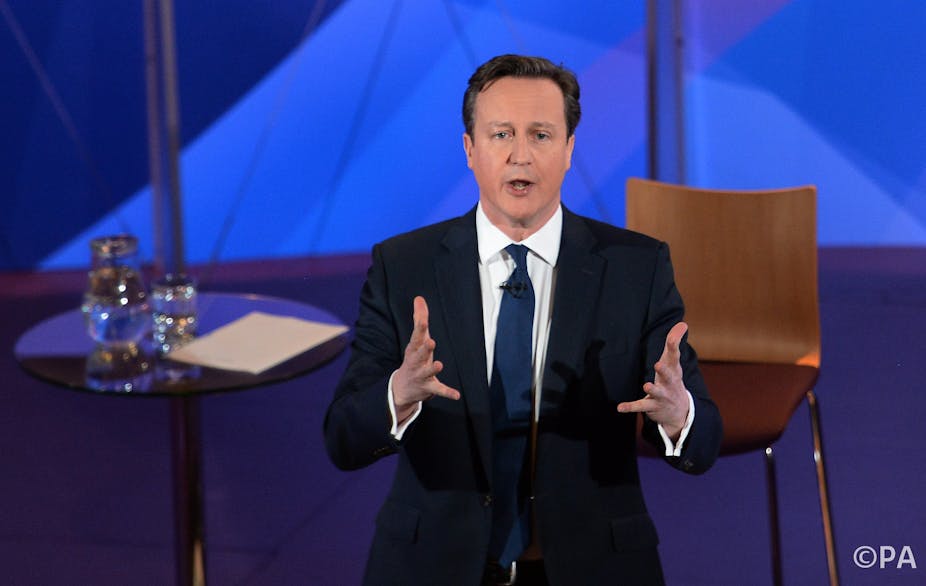Over the two years that this election campaign has effectively been running, it has arguably been the most heavily managed in UK history. The tendency has only intensified as we approach polling day and the opinion polls point to an uncertain outcome.
Television coverage of the campaign trail, which has dominated the election once again, has been faithfully relaying the latest pseudo-events constructed by the parties as news. The 24/7 news channels are particularly vulnerable, such is the need for slick packaged visuals to help fill airtime.
By now the viewing public must be somewhat inured to images of the party leaders surrounded by carefully selected enthusiastic supporters, many holding placards with key party slogans, strategically placed to appear in shot for media camera crews. We also now have the “spontaneous selfie”, as party leaders have endless photos taken with excited supporters.
Not only are these ideal for being shared on new media, they are also filmed by old media for inclusion in news reports on evening news bulletins. What better way to appear normal and connected with real people than to participate in the selfie phenomenon? In reality, one senses they would struggle to hold a conversation with them.

Message and candidate control have been a key element of the main parties’ communication strategies. There has been a grim determination to ensure that party leaders do not actually meet any real people, for fear of unscripted moments like when Gordon Brown referred to a voter as a bigot in 2010 without realising he was being recorded. Such “moments of truth” are anathema to the carefully constructed images and narratives of the campaign managers.
When is a debate not a debate?
Another defining feature of this presidentialised campaign has been the stilted debate formats. They have provided very little debate – and indeed no one-on-one clashes between the two rivals for Number 10 – as intended by Conservative Party strategy. Instead we have been treated to the regurgitation of pre-crafted sound-bites. A rare exception was the palpable audience frustration during BBC Question Time on April 30, where we glimpsed public desire for some straight answers from politicians.
These debates might have offered little new in terms of content and policy, but they attracted a huge amount of media commentary. This meta-coverage is exemplified by the introduction of the spin room into the election lexicon. The spin room represents the mainstream media’s open complicity with the campaign managers to manufacture the news.
Perhaps the most glaring example was when David Cameron did not participate in a BBC leaders’ debate, but his spin doctors were allowed to interpret the event for journalists in the spin room. In effect the spin room offers a platform for the instant recycling of the latest party briefing, however thin, in what now apparently passes for sophisticated and informed analysis. Just because many reporters and correspondents openly fess up to this contrivance does not make it any more illuminating or helpful to the voter.
It is clear that social media has been factored into election strategies as well, though somewhat uncreatively. The main parties appear highly risk averse on these digital platforms. And there is a sense that much of this is consumed by the politically converted and committed. Whether all the trolling and extolling that passes for political dialogue within partisan filter bubbles is reaching and influencing undecided voters remains to be seen.
The torture chamber
If the TV debates, spin rooms and social media “buzz” represent an electoral echo chamber then the partisan British press resemble a torture chamber, particularly for Ed Miliband. He has faced relentless negative coverage in Tory-supporting newspapers, and this appears to be intensifying in the final stretch of the campaign.
Little wonder that Labour was keen to fight this campaign on television and radio. This is just as evident as the Tory campaign calculus to avoid formats where Cameron may become unstuck, place leadership at the centre of its campaign, and continually repeat its key messages (Conservative = competence, Labour = chaos x SNP influence).
It is hard not to conclude that the spin doctors in the main parties appear to have based their communication strategies on a rather pessimistic view of the British public. On this logic, voters cannot be trusted to make informed judgements on complicated public policy matters, and politicians must stick to very basic messages that might “break through” and resonate.

Lynton Crosby, the chief Tory party strategist, is a recognised master of this style of dog-whistle campaigning. It plays to popular prejudices and identifies wedge issues that divide parties from their core support. The repeated Tory emphasis on the role and legitimacy of the SNP is perhaps the most high-risk wedge issue in British public life just now. How this plays out may have implications well beyond the formation of the next government and well beyond the control of the party spinners.

